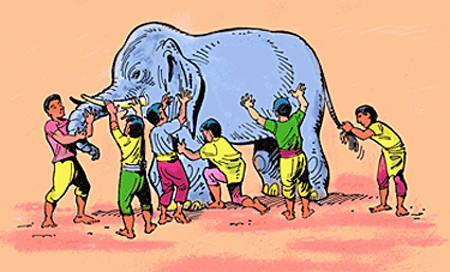There is an excellent tale, by American poet John Godfrey Saxe (1816-1887), that is based on a fable told in India many years ago. It is a good warning about how our sensory perceptions can lead to some serious misinterpretations; especially when we focus on one part in relationship to the whole. It also deals with how people perceive things from where THEY stand not from were YOU stand. The tale in entirety follows this post.
While this is an excellent tale about perception, it is also a cautionary tale for anyone trying to market a product to a general population. While you are trying to "sell" an elephant, certain features of the elephant will be more important and more pronounced than others. So, what you as a good marketer have to do is figure out what are the most profitable market segments to sell to and then highlight those features prominently, that includes determining if someone wants the "whole" elephant. In some instances, and if possible, you will have to unbundle your products (sell just the rope and snake), to hit your target market, and when you cannot unbundle, you have to show the value of the chief features of your product, and "just throw" in the other features for free.
In any case, never assume your market is monolithic, but also make sure you just do not focus on one segment at the exclusion of all others. You DO NOT want to sell an elephant for the price of a rope or a fan!
_________________________________________________

It was six men of Indostan
To learning much inclined,
Who went to see the Elephant
(Though all of them were blind),
That each by observation
Might satisfy his mind
The First approached the Elephant,
And happening to fall
Against his broad and sturdy side,
At once began to bawl:
"God bless me! but the Elephant
Is very like a wall!"

The Second, feeling of the tusk,
Cried, "Ho! what have we here
So very round and smooth and sharp?
To me 'tis mighty clear
This wonder of an Elephant
Is very like a spear!"

The Third approached the animal,
And happening to take
The squirming trunk within his hands,
Thus boldly up and spake:
"I see," quoth he, "the Elephant
Is very like a snake!"

The Fourth reached out an eager hand,
And felt about the knee.
"What most this wondrous beast is like
Is mighty plain," quoth he;
" 'Tis clear enough the Elephant
Is very like a tree!"

The Fifth, who chanced to touch the ear,
Said: "E'en the blindest man
Can tell what this resembles most;
Deny the fact who can
This marvel of an Elephant
Is very like a fan!"

The Sixth no sooner had begun
About the beast to grope,
Than, seizing on the swinging tail
That fell within his scope,
"I see," quoth he, "the Elephant
Is very like a rope!"

And so these men of Indostan
Disputed loud and long,
Each in his own opinion
Exceeding stiff and strong,
Though each was partly in the right,
And all were in the wrong!
Moral:
So oft in theologic wars,
The disputants, I ween,
Rail on in utter ignorance
Of what each other mean,
And prate about an Elephant
Not one of them has seen!

While this is an excellent tale about perception, it is also a cautionary tale for anyone trying to market a product to a general population. While you are trying to "sell" an elephant, certain features of the elephant will be more important and more pronounced than others. So, what you as a good marketer have to do is figure out what are the most profitable market segments to sell to and then highlight those features prominently, that includes determining if someone wants the "whole" elephant. In some instances, and if possible, you will have to unbundle your products (sell just the rope and snake), to hit your target market, and when you cannot unbundle, you have to show the value of the chief features of your product, and "just throw" in the other features for free.
In any case, never assume your market is monolithic, but also make sure you just do not focus on one segment at the exclusion of all others. You DO NOT want to sell an elephant for the price of a rope or a fan!
_________________________________________________

It was six men of Indostan
To learning much inclined,
Who went to see the Elephant
(Though all of them were blind),
That each by observation
Might satisfy his mind
The First approached the Elephant,
And happening to fall
Against his broad and sturdy side,
At once began to bawl:
"God bless me! but the Elephant
Is very like a wall!"

The Second, feeling of the tusk,
Cried, "Ho! what have we here
So very round and smooth and sharp?
To me 'tis mighty clear
This wonder of an Elephant
Is very like a spear!"

The Third approached the animal,
And happening to take
The squirming trunk within his hands,
Thus boldly up and spake:
"I see," quoth he, "the Elephant
Is very like a snake!"

The Fourth reached out an eager hand,
And felt about the knee.
"What most this wondrous beast is like
Is mighty plain," quoth he;
" 'Tis clear enough the Elephant
Is very like a tree!"

The Fifth, who chanced to touch the ear,
Said: "E'en the blindest man
Can tell what this resembles most;
Deny the fact who can
This marvel of an Elephant
Is very like a fan!"

The Sixth no sooner had begun
About the beast to grope,
Than, seizing on the swinging tail
That fell within his scope,
"I see," quoth he, "the Elephant
Is very like a rope!"

And so these men of Indostan
Disputed loud and long,
Each in his own opinion
Exceeding stiff and strong,
Though each was partly in the right,
And all were in the wrong!
Moral:
So oft in theologic wars,
The disputants, I ween,
Rail on in utter ignorance
Of what each other mean,
And prate about an Elephant
Not one of them has seen!

Comments